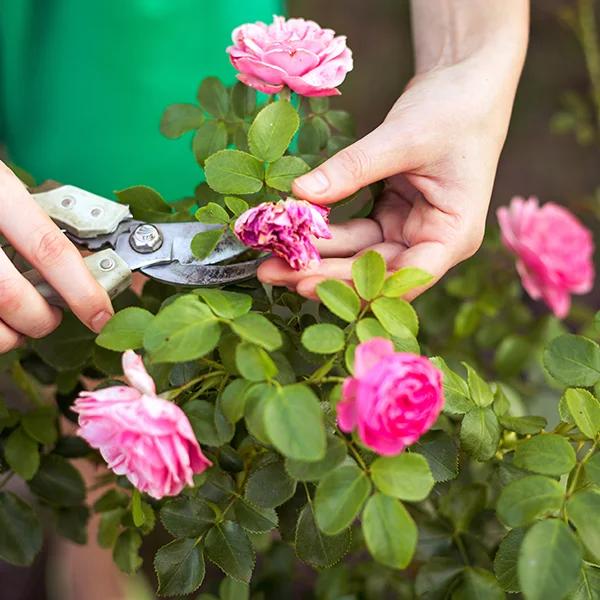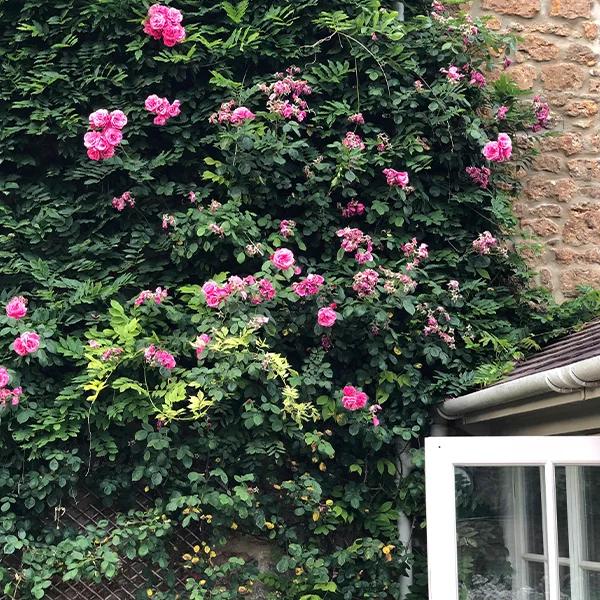Climbing roses are pruned differently, into a framework of long, ideally winding canes that cover its supports.
Table of Contents
How to Prune Rose Bushes
Pruning increases flower production and keeps your roses tidy. It is easy, although we recommend a nice pair of goatskin gloves!
For best results, different roses are treated in slightly different ways, but it is far better to prune your roses badly than not at all: roses are tough as rocks and will grow back!
Sharp cutting implements (secateurs, pruning shears or saws) make clean cuts, which heal faster and provide less opportunity for fungal infections to enter.
The A-grade gardener will disinfect their implements between each rose bush.
Rose prunings & leaves are usually burnt or thrown in the green waste for convenience: the woody old stems are slow to decompose, and they can pass on fungal diseases through your compost.
As always, prune the following at any time:
- Dead, dying, damaged and diseased stems back to a healthy point. Cuts on upright stems should be diagonal so that rainwater flows off the wound.
- Crossing stems that rub against each other. Cut one of the crossing stems as far back as is necessary to prevent this.
- Spindly growth, which never turns into strong sturdy stems. Cut it out to favour more promising stems.
Deadheading is relevant for all repeat flowering (remontant) roses, but is not relevant for roses that flower once (see below) and/or for roses that bear attractive hips in the autumn (such as rosa rugosa and rosa moyesii ‘Geranium’).
Deadheading encourages more flowers by stopping the plants producing hips and seeds. To deadhead, snap the rose head off just behind where the stalk meets the bulge of the flower calyx. Where you have a whole cluster of flowers at the end of a stem – such as with floribunda roses – cut the whole cluster off.
When you are pruning, check the roots of your roses to see they are firm in the ground. If one is not, firm the soil around the base of the plant and prune that rose back a bit harder so the wind has less plant to blow about (thereby dislodging the roots).

Pruning Repeat Flowering Shrub Roses
This section covers the basics of pruning for all Repeating (remontant roses) including all Bourbon, China, Portland and English shrub roses, as well when you should prune rose bushes.
In the UK, the hard prune before Winter is a good tactic for reducing wind rock, followed by a second light prune in Spring.
The First Year
In its first year, your rose needs to develop its root system. Therefore, pruning will be less fierce than in later years. Pruning should happen in the late February after its first flowering when you can best see the structure of the plant. In the North, wait until March. But, if you forget, you can still prune, even in April.
Concentrate on removing dead, diseased, damaged or dying shoots. Then cut all the shoots back by about 10 cms. Next step back and look at the shape of the rose and draw an imaginary semi-circle around it. Any shoots that are sticking out should be taken back to the arc of the semi-circle. Prune out any shoots that cross or rub against one another. Any remaining foliage that is still on the rose post winter should be taken off and disposed of. The following summer, you need to deadhead as above.
The Second Year
More mature but still with room for root development, your rose needs the amount of top growth to be kept to that which can be supported by the root system. Unlike the first year, cut healthy shoots back by a third instead of 10cms. Then, as before, adjust any longer shoots so that they fit into the basic shape of the bush.
Don’t forget to remove all the dead and dying leaves that have remained over winter, and deadhead throughout the following summer.
The Third Year
Your rose is mature, and you can adjust its size and shape to a greater degree than before.
Cutting back harder encourages stronger regrowth.
- If your rose is looking small and spindly, cut back the stems by half or more to force strong regrowth.
- If you like the size, maintain it with light trimming that tips the shoots, making them bush out and slow down.
Deadhead throughout the summer.
How to Prune Mature Rose Bushes to Prevent Wind-Rock
Wind rock in the cold seasons is avoided by pruning shrub roses back in time:
This time of the year, try to reduce all the roses by about a third. It saves them getting blown around with the wind and the Autumn gales, which just rocks the roots: it’s called wind-rock. If they get too high, they rock around like that, and they just don’t get away very well. So, this time of year, we try to get rid of all this old, thin, spindly growth, and it just makes it easy to prune in the spring, when you come down to give them a proper prune. Look at it, decide where you want to go, and what I’ve tried to do is vase shaped to the middle. So, a lot of this is all crossing over, so we’re trying to take this down…that’s about right. You can take all of the thin spindly shoots off, take any snags or any dead wood that’s died over the summer. Take all that out, at any dead snags from old pruning cuts, like that one there. If you don’t take it away, it’ll just keep on going further and further down stem. So, a nice clean cut, take it straight off. Any old prunings, burn them, put them on bonfire, but don’t compost them* because they’ll carry fungal diseases, anything like that. So, in the spring, when we come to prune it again, we’ll follow these shoots down, find a bud, and then prune it hard back, prune it back to an outward facing bud, and then you’ll get a nice bowl shaped rose, with plenty of flowers on top.TRANSCRIPT3
Continue pruning as for year 3; when you get a build up of old wood in the centre, you may cut this out to encourage a new shoot from the base of the plant.
The above are the general principles for all repeat flowering roses, with a few adjustments for Hybrid Teas, or Floribundas:
Pruning Hybrid Tea Roses
While the basics remain the same, hybrid tea roses should be cut back hard down to 15cm from the ground. You should be able to see where last year’s growth began and that is where your cuts should be. Stems that have flowered for three years or more should be cut out entirely at the base. New shoots will then appear that bear even better blooms.
Pruning Floribunda Roses
Recognisable by the clusters of flowers that they produce at the end of their stem, floribunda roses are not as tough as hybrid teas. So be more gentle and only cut them back to 30-45cm from the ground. Again, stems that are over 3-4 years old should be cut back to the base.

Pruning Single-Flowering Shrub Roses
If your rose bush only flowers once a season, it is probably either an older variety of rose or a descendant of one.
Repeat flowering has been bred into modern roses to extend their interest over the summer. This means that the pruning advice differs.
Here the emphasis is less on cutting back the stems. This is because their habit is to arch beautifully, giving these roses their elegant shape. More importantly, many of them actually flower better on older wood. Instead, you should try to encourage new growth from the base of the plant.
This advice applies to Species, Alba, Centifolia, Damask, Gallica, Hybrid Musk (e.g. Penelope and Buff Beauty), Musk, Rugosa, Scots and Sweet Briar varieties that only flower once in summer. In reality, most rarely need pruning at all, except to cut out old wood and to keep them to their allocated place and size.
The First Year
As with the repeat flowerers, your rose will be developing its root system and it should not be pruned in the winter after planting.
Instead, after it has finished flowering remove diseased, damaged, dying or dead wood and crossing or rubbing stems.
The Second Year
Because these roses are not usually grafted some may have sent out suckers and new shoots that will also flower and should be kept. Proceed as for the first year.
The Third Year
The centre of the plant may become crowded with old and new wood. If so, take out some older stems at the base. This may not be necessary depending on how well the rose is doing.
From then on, do an annual check after flowering to remove congested or old wood in addition to any unhealthy or dead stems.
If the plant becomes leggy – the lower parts of the rose are bare and unproductive – cut several of the stems out at the base and you will see new bushy growth is regenerated next season. If your roses then become too tall, just cut them back to size after flowering in late summer.
Pruning Rambling Roses
Most rambling roses also only flower once each year, and they need little pruning.
If they are running up a tree or covering a big shed, you can leave them alone, other than to control their size at the edges.
If your mature rambler is accessible, the best practice is to cut out some of the oldest wood at the base, to allow new shoots to replace them. These new shoots will produce better flowers.
But this can be done inconsistently, unlike with pruning climbing roses.
